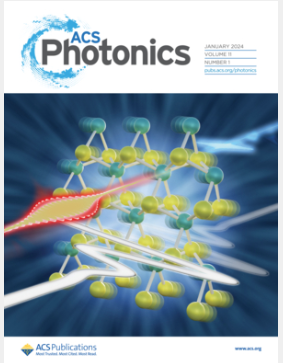增强激子-等离子体相互作用使wse2 -金纳米颗粒杂化体系的近场光致发光观测成为可能
IF 6.5
1区 物理与天体物理
Q1 MATERIALS SCIENCE, MULTIDISCIPLINARY
引用次数: 0
摘要
单层过渡金属二硫族化合物,如二硒化钨,由于其减少介电屏蔽和直接带隙,导致高激子结合能和强光致发光,近年来引起了人们的广泛关注。单层过渡金属二硫族化合物与等离子体纳米粒子的集成通过局域表面等离子体和强电磁约束增强了它们的光电性能。利用近场成像技术研究了单层二硒化钨和金纳米粒子阵列杂化体系的光致发光响应。我们的研究表明,通过近场相互作用,激发金纳米粒子显著增强了激子发射。我们研究了激子-等离子体-极化子耦合对混合系统远场响应的影响。在那里,我们观察到激子诱导的透明现象,这表明了中间耦合机制,并有助于共振增强单层二硒化钨中的光-物质相互作用。混合系统的二次谐波产生强度遵循混合系统的线性谱响应,从而证明了表面等离子体激子与激子之间的耦合增强。我们的研究为中间耦合对混合激子-等离子体系统光学特性的影响提供了见解,这对于先进纳米光子器件的发展至关重要。本文章由计算机程序翻译,如有差异,请以英文原文为准。

Enhanced Exciton–Plasmon Interaction Enabling Observation of Near-Field Photoluminescence in a WSe2–Gold Nanoparticle Hybrid System
Monolayer transition metal dichalcogenides, such as tungsten diselenide, have recently attracted considerable attention due to their reduced dielectric screening and direct bandgap, which result in high exciton binding energy and strong photoluminescence. The integration of monolayer transition metal dichalcogenides with plasmonic nanoparticles enhances their optoelectronic properties through localized surface plasmons and strong electromagnetic confinement. We investigated the photoluminescence response of the hybrid system of monolayer tungsten diselenide and gold nanoparticle arrays through near-field mapping. Our study demonstrated a significant enhancement of the excitonic emission by the excited gold nanoparticles via near-field interaction. We examined the impact of exciton–plasmon-polariton coupling on the far-field response of the hybrid system. There, we observed the phenomenon of exciton-induced transparency, which indicates the intermediate coupling regime and helps resonantly enhance the light-matter interaction in monolayer tungsten diselenide. The second harmonic generation intensity from the hybrid system was shown to follow the linear spectral response of the hybrid system, thereby demonstrating the enhanced coupling between surface plasmons and excitons. Our research offers insights into the impact of intermediate coupling on the optical properties of hybrid exciton–plasmon systems, which is crucial for the development of advanced nanophotonic devices.
求助全文
通过发布文献求助,成功后即可免费获取论文全文。
去求助
来源期刊

ACS Photonics
NANOSCIENCE & NANOTECHNOLOGY-MATERIALS SCIENCE, MULTIDISCIPLINARY
CiteScore
11.90
自引率
5.70%
发文量
438
审稿时长
2.3 months
期刊介绍:
Published as soon as accepted and summarized in monthly issues, ACS Photonics will publish Research Articles, Letters, Perspectives, and Reviews, to encompass the full scope of published research in this field.
 求助内容:
求助内容: 应助结果提醒方式:
应助结果提醒方式:


